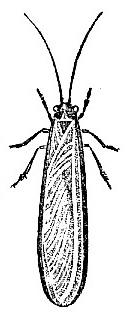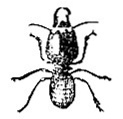1902 Encyclopedia > Ant > Termites/White Ants: Organised Communities; Life Cycle; Distribution.
Ant
(Part 13)
(C) Termites / White Ants
Termites/White Ants: Organised Communities; Life Cycle; Distribution.
A brief description of the Termites, or white ants, may appropriately conclude the present article. These forms have already been stated to be entirely different from the familiar and true ants, and to belong to the Neuropterous insects, whereas the true ants are classed with the Hymenoptera.

Fig. 4 -- White Ant (Termes bellicosus). Male.
They resemble the true ants in living in highly organized social communities, and in being endowed with as high and as specialized instincts. But they differ from them, first, in the fact that they do not undergo a complete metamorphosis, that is, the termite larvae and pupae resemble the perfect insect, and do not pass through the defined stages of change and development characteristic of the true ants, bees, and other insects. The young Termite, in fact, differs from the ordinary adult only in the non-possession of eyes, and from the sexual forms in the non-development of wings.
The white ants inhabit the tropical regions of the world generally, but are found in the greatest abundance in tropical South America. Their nests form characteristic structures, rising sometimes to a height of 5 or 6 feet, and constructed of earthy particles worked into a mass as hard and durable as stone.
Many species of Termites are known, but they resemble one another in essential structure and habits. As indicated by their popular name, they are of a whitish colour and are soft-bodied.

Fig. 5 -- White Ant (Termes bellicosus). Soldier.
The Termite community consists, as in the true ants, of males, females, and workers or neuters. In the true ants the latter are undeveloped females, whereas in the Termites the sex of the neuters is wholly undeterminable; and in addition the workers are invariably divided into two distinct classes: the "soldiers," with largely-developed jaws, whose sole office is to defend the community; and the ordinary "workers," on whom devolves the entire labour of the nest. Both classes of neuters are blind; and from a close examination of the eggs, the distinctions, not only between males and females, but also between the soldiers and workers, may be easily seen.
The difference in food, so powerful in the development of sex and characteristics in other insects, does not therefore operate in the case of the Termites.
The entire white ant colony and species also exhibits a division into subordinate groups and classes, the recognition and character of which are very difficult of determination. And on this, as well as upon other grounds, the organization of the white ant community is generally to be regarded as of a higher type than that of the familiar and true ants.
Read the rest of this article:
Ant - Table of Contents
|

